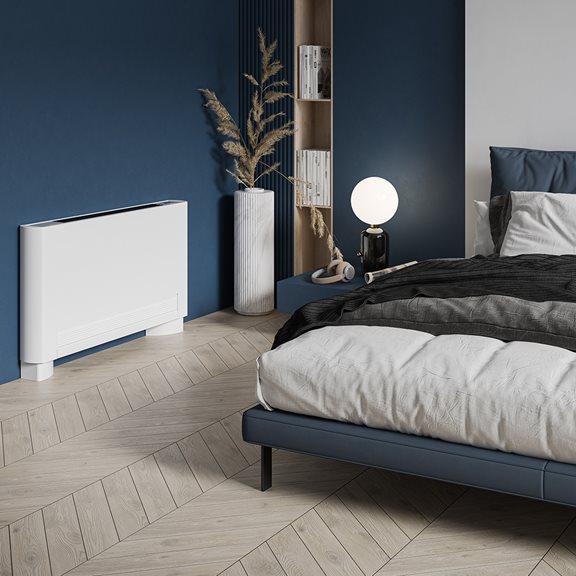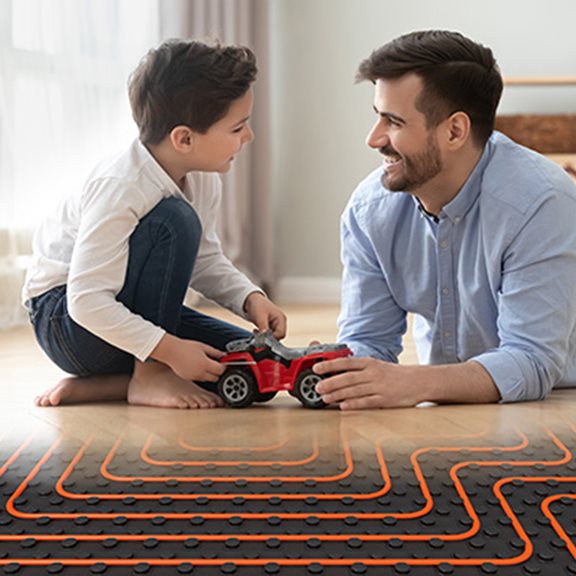Underfloor heating: the ideal solution for sustainable homes
When you build or renovate, you're of course looking for the most efficient heat delivery system. But which system do you choose? Heating your home can be done in several ways, although radiators and convectors remain by far the most popular choice. But underfloor heating is also a smart option that offers many advantages. Especially in combination with PV solar panels and a heat pump, they are a future-proof choice.
Radiators vs. (fan) convectors
Convectors operate at low temperature and heat primarily on convection, heating air. Radiators are a high-temperature delivery system and combine convection and radiant heat, also heating objects and people. The advantage of convection is that your room heats up quickly; the disadvantage is that when the unit is turned off, you lose all the heat again quickly. Radiant heat, on the other hand, heats objects and surfaces that in turn release heat into the room. Therefore, the heat will remain present longer when you turn off the heater and is also distributed more evenly, resulting in fewer temperature fluctuations.
In addition to ordinary convectors, there are also ventilo-convectors. A ventilo-convector is equipped with a fan that blows warm air into the room. This creates an even temperature distribution and gives you a fast and efficient heating system. Ventilo-convectors work at a low temperature which, unlike radiators, allows you to combine them well with an air-to-air heat pump. In combination with a reversible heat pump or a separate cold water source, you can also use the fan coil unit in the summer to cool your home.
Underfloor heating as an ideal solution for sustainable homes
Another popular option for a heat delivery system is underfloor heating and cooling. This system also works at a low temperature and is therefore perfect to combine with a heat pump. Like radiators, it works on the principle of radiant heat, but is more economical to use. Underfloor heating can easily be set 2°C lower than radiators and will still provide the same pleasant wind chill. Floor heating set at 19°C, therefore, gives the same comfort as radiators set at 21°C. In addition, with this system, as with fan coil units, you have the option of cooling your home. Although the effect is more limited than with a fan coil unit. An interesting difference is that cooling with underfloor heating is done in a passive way, which is good news for your energy bill.
The benefits of underfloor heating
- Comfort
Underfloor heating offers by far the greatest comfort. Because the floor always feels nice and warm, you can still walk around your house in socks or bare feet even in winter. The heat is also distributed evenly, so you won't get cold spots. - Works at low temperatures
Underfloor heating is energy efficient. Because it works at low temperature, you need less energy to heat your home. This, in turn, results in lower energy costs. - Takes up no space
Underfloor heating is built into your floor. So you do not need to provide radiators, leaving you more space to place cabinets or other furniture,. So you can completely arrange your home the way you want it. - Fresh air
With convection, the air in the room is moved. This can blow up dust, which aggravates allergies. With radiant heat, this is not the case. This heat is also usually perceived as very pleasant.
Underfloor heating and heat pumps
Since underfloor heating works at low temperature, you can combine it perfectly with a heat pump. If you also have PV solar panels to generate your own energy, you create the ideal combination for an energy-efficient home. The green energy you generate yourself with solar panels can be used to power your heat pump, so you need less electricity from the grid. The heat pump extracts heat from the ground, air or water and in turn releases that heat to the water circuit of the underfloor heating system. The heated water then flows through the heating pipes under your floor, heating your home. If you want to combine underfloor heating with a heat pump, your home should have the lowest possible heat loss. If your home is less well insulated, you will unfortunately not achieve optimal efficiency.
Underfloor heating and renovation
Since 2023 in new construction you are obliged to heat at low temperature. Underfloor heating then often appears to be an obvious choice. This is different for renovations. Here you often have a limited installation height, making a wet system no longer possible. If your height is limited, then milled underfloor heating and underfloor heating according to the dry system is a possibility. Are you opting for a total renovation, with new screed? Then you usually have sufficient build-up height for a wet system.
- Wet system
This is the standard choice for underfloor heating in new construction. The heating pipes lie directly in the screed. To avoid cracks in your screed, a reinforcement network is also provided. For this system, you need a construction height of about 18 to 20 cm. - Underfloor heating milled in
With this system, the existing floor finish is removed and slots are cut in the existing screed layer. For this, the chapel layer must still be in good condition. The new floor finish can then be placed directly on top of it. Ideal for a limited build-up height. - Dry system
In dry system floor heating, the heating pipes are not in the screed, but in preformed insulation plates. The material of those plates ensures fast heating time and perfect heat distribution. On top of your slabs comes a thin screed and your floor finish. So for this option, you don't need a large build-up height. - Electric floor heating
A fourth and final option is electric floor heating. This can also be laid perfectly when you have a limited build-up height. The disadvantage is the high cost of electricity. Electric floor heating is therefore not recommended for large rooms that you need to heat continuously.



